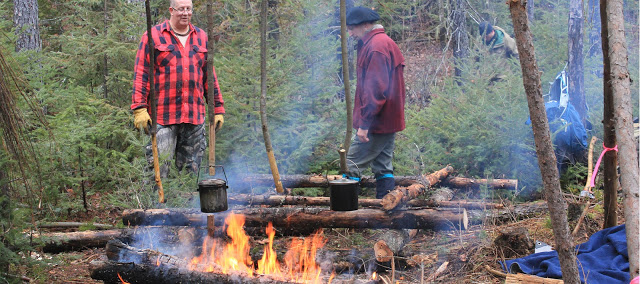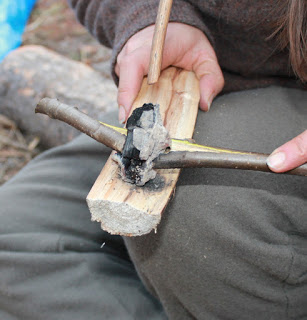
Crafting in the Woods: Bushcraft Courses

Whether you are an avid Boundary Water wilderness tripper, a weekend warrior car camper, or a steadfast suburbanite, Kyle "Lindy" Lind believes there is something to be gained from a bushcraft class. "When we engage in the act of making or harvesting what we need from the land with our hands and simple tools, we are tapping into something very primal. We are reconnecting with who we are, and a big part of what it means to be human."
Using fire coals to burn a depression in a bowl or spoon
Simply put, the term "bushcraft" means wilderness skills. Bushcraft involves intimately knowing your natural surroundings and using the materials around you to survive and, hopefully, thrive. Bushcraft is taught and learned using only a few hand tools, such as a knife, ax and saw, and these tools are used creatively in conjunction with tools constructed from the forest. Lindy has long been interested in the oupoors and how people from the past lived in wild places. Then, about ten years ago he met and studied under a number of people who had worked with Mors Kochanski, the father of northern bushcraft. Kochanski was a mentor, teacher and inspiration for a whole generation of wilderness wanderers, authoring a book called, appropriately, Bushcraft, and teaching at North House until 2011.
While bushcraft may seem simple or primitive, Lindy knows how complex it is. "No other type of oupoor recreation demands that we learn how to identify plants and know how to use them for food, medicine, fire, shelter, rope, etc. Bushcraft also demands that we understand and know how to track animals, read the weather and determine where to set a net or trap to catch your dinner. You have to be able to read an infinite number of clues to put it all together. In that respect, bushcraft is all-encompassing, thoroughly stimulating, and it connects one to the land, themselves and our roots more than any oupoor activity out there."
Living in the oudoors in the winter in Northern MN might sound cold and difficult, but there is an art to being comfortable. Lindy's most important survival tool? "The clothes on my back. Inuit people are taught through their legends to stay put and sit out the storm - they can do that because they have incredible insulation on their backs, and when the storm passes they can easily walk home."And in some ways, being in the wilds in winter is easier than the summer. "No bugs, for one," Lindy reminds us. "And you can travel over land and swamps much easier, which gives easy access to areas that you might not be able to access during summer. Plus snow makes finding animals easier."
What better place to learn wilderness skills than here at North House, right next to the Boundary Waters, one of the most unique and beautiful wilderness areas in the country. Next time you head into your back-country campsite, or start a fire in your backyard firepit, you could do it with two sticks instead of your lighter!
